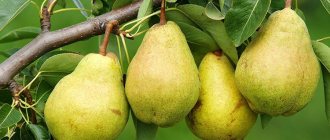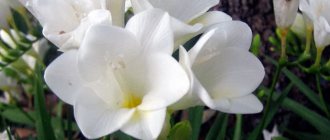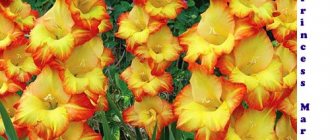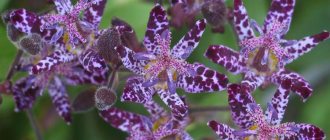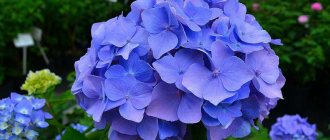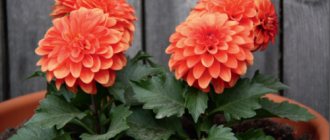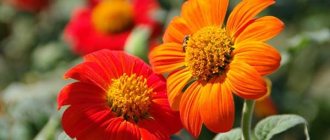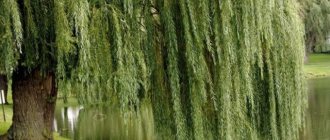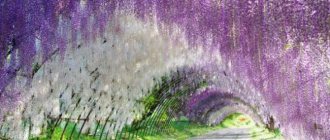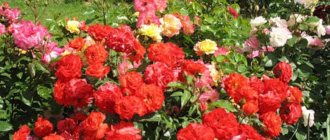Trillium got its name for a reason. The plant combines the number three in an unusual way. It has three leaf blades on the stem, three petals on the inflorescence, three sepals and it takes three years for it to enter the phase of its highest decorativeness.
The culture belongs to the melanthiaceae family and there are up to 30 species in its genus.
America and Asian countries are considered to be the birthplace of the plant. In Canada, trillium is considered valuable, so it is prohibited to dig it up or cut it. [Hide]
General information
Despite the fact that the homeland of trillium is very far away, it can be found in the garden plots of Russian gardeners. The plant begins to bloom in April and is one of the first to add beauty and decorativeness to the garden.
However, the culture blooms for only about two weeks, but this does not at all negate its elegance and attractiveness. The inflorescences can be either modest white or double with various bright colors, depending on the variety.
Growing trillium is not very easy, but if you follow all the recommendations of experienced gardeners, then this elegant perennial will delight you with its decorative properties for many years.
Varieties and types of trillium
Trillium Kamchatka - Kamchatka, China and Sakhalin are considered to be the birthplace of the plant. It is a perennial, reaching a height of up to 50 centimeters. The stem of the crop is straight, at its top there are three solid diamond-shaped, pointed leaf plates, the width of which reaches 12 centimeters. The inflorescences are small and white. The fruits are edible, presented in the form of a brown-green box. Trillium blooms from mid-April to early May.
Trillium grandiflora - in the wild, the crop grows in North America and Kamchatka. The roots of the flower are short, tuberous. The stem is very short, but the peduncle reaches up to 50 centimeters in length. There are three large dark green diamond-shaped leaf plates on it. The inflorescences in the first year after planting are small, but after three years they become large and very beautiful. The petals have a white tint, which towards the end of flowering gives way to pale pink. The crop blooms in May for two weeks.
Trillium Terry is an ornamental plant variety. The bush reaches a height of up to 30 centimeters and has large, wide leaf plates of a dark green hue. The inflorescences are large, white with corrugated, numerous petals. One bush can have up to 50 inflorescences. Trillium blooms in May. After flowering, the plant retains its decorative properties thanks to its unusual leaf blades.
Trillium erecta - the birthplace of the plant is America. The shrub reaches a height of up to 40 centimeters and has large, diamond-shaped, dark green veiny leaf plates with a pointed end. The inflorescences are three-petaled, burgundy in color with a pungent odor. The plant blooms in early May, and its seeds ripen at the end of August.
Trillium sessile - the shrub reaches a height of up to 25 centimeters and has three large, diamond-shaped leaf plates of a bluish-green hue with a silvery sheen at the top of the trunk. The inflorescences are small, sessile, red-brown in color with a spicy aroma. The crop blooms in May and bears fruit in August.
Trillium Sessile
Luxurious shrub reaching a height of 35 centimeters. The leaf blades are large, wide, dark green with marbled streaks. The inflorescences are three-petaled, reddish-brown in color, with a pleasant, persistent, spicy aroma. This variety is the latest to bloom. Its flowering time is in June.
Trillium Pendulum - this plant reaches a height of up to 30 centimeters, has an erect stem with diamond-shaped, large dark green leaf plates. The inflorescences are small with three burgundy or white petals and a yellow center. The plant blooms in May, and the seeds ripen in September.
Trillium Yellow - the shrub reaches a height of up to 25 centimeters and has large, diamond-shaped, dark green leaves with marbled streaks. The inflorescences are sessile, small, lemon-colored. The crop blooms in May and bears fruit at the end of August.
Trillium Wavy - the birthplace of the plant is North America. The shrub reaches a height of up to 60 centimeters and has a thin, single stem, with large, ovate, dark green leaves with a sharp tip. The inflorescences are white with crimson stripes in the middle and three white petals with corrugated edges. Trillium blooms in May and produces seeds in September.
Trillium wedge-shaped - the plant reaches a height of up to 30 centimeters. It has large, wide, diamond-shaped leaf blades with white spots. Inflorescences can be brown, burgundy, yellow or two-colored. They have a pleasant aroma. The flowering time of the crop is in May.
Trillium Tiny
The earliest variety of trillium. Its flowering time occurs at the end of April - beginning of May. The height of the bush reaches 15 centimeters. The leaves are dark burgundy in color, diamond-shaped and have a pointed tip. The inflorescences are white, small, three-petaled, odorless.
Pacific trillium ( Trillium ovatum ) – the plant is native to Canada. The height of the flower reaches 50 centimeters. The leaf blades are large, wide with visible veins of a dark green hue. The inflorescences are small, with white petals, but they can be pinkish or dark burgundy. The flowering time of the crop is in April.
Trillium Recurvatum ( Bloody Butcher or Prairie Trillium ) – North America is considered to be the birthplace of the culture. The height of the bush reaches 30 centimeters. The leaf blades are medium-sized, diamond-shaped with a pointed end of a dark green hue. The inflorescences are sessile, small with red-violet petals. The plant blooms from late May to early June.
Trillium Flexipes ( Bent or Hanging Trillium ) - the plant reaches a height of up to 50 centimeters. The leaves of the crop are large, diamond-shaped with a pointed end. They are dark green with marbled spots. The inflorescences are three-petaled white, with a yellow center. Flowering time lasts from late May to early June. Fruits in the form of red berries appear in August.
Trillium. Popular types
At the moment, about 30 species of trillium are known. They differ both in appearance and in the timing of flowering. According to the timing of flowering, all types of trilliums are conventionally divided into 3 large groups:
- early trilliums;
- medium trilliums;
- late trilliums.
All varieties of trilliums also differ in the position of the flower on the peduncle:
- sessile flowers. The peduncle is practically absent and the flower “sits” on the leaves;
- the peduncle is straight and facing upward. The flower grows straight on a rather long peduncle;
- the peduncle bends towards the ground. A similar type of peduncle is characteristic of drooping trillium, for example. Its flower “looks” down.
Trilliums do not have a very rich color palette. Flowers, depending on the variety, can have the following color options:
- snow-white flowers;
- snow-white flowers with a pinkish center;
- dark red flowers;
- purple;
- flowers of greenish shades.
If you decide to plant this plant on your site, be sure to read the information about flowering times, planting and care features.
Trillium Kamchatka
Trillium Kamchatka can be found quite often in the regions of Russia and Japan. Residents of Kamchatka call this plant “cuckoo tomarks”. In Japan, Kamchatka trillium is given not only decorative value, but is also used for medicinal purposes, and the trillium fruits are eaten. To see the charming flowers of this variety of trillium you will have to wait about 3-4 years after planting. The flowering phase begins in late spring and lasts about 2 weeks.
Trillium Small
The variety was named after the botanist Small. In the wild it can be found on the islands of Japan and Russia. Grows among tall grass, stone meadows and forests. The flowers are painted in a beautiful red-purple hue, and the fruits can be eaten. It is inferior in height to Trillium Kamchatka and is much less common.
Trillium Chonoski
The plant received this sonorous species name in honor of the Japanese botanist. This variety of trillium can be found in the Himalayas, the islands of Japan, and Korea. On a stem up to 40 cm high there is a single snow-white flower. Trillium Chonoski in the wild looks quite impressive, but achieving the same flowering on the site is problematic.
Trillium erecta
Trillium erecta grows up to 60 cm in height. Depending on the variety, the flower can be purple, dark red, or white. Grows freely in the forests of Canada and the USA. Americans speak rather strangely about this beautiful plant, calling it “Smelly Willy.” Of course, the plant has a rather specific smell, but you can’t feel it at all unless you bring your nose to the center of the flower. The smell of “wet dog,” as they say in the homeland of Trillium erecta, will definitely not be on your site.
Trillium inclined
This species of trillium grows exclusively in the Great Lakes region of the United States. Prefers to grow on fairly calcareous soils. Trillium reaches about 0.5 m in height. Its leaves are ovoid and elongated. The berry is colored pinkish, and its pulp smells like fruit.
Trillium yellow
Yellow trillium attracts gardeners with its unpretentiousness and decorative appearance. The flower has a beautiful lemon or light yellow tint with a greenish tint. If you sniff well, you can catch a light aroma of lemon emanating from the plant. In its homeland it grows almost everywhere, even near roads and ditches.
Terry trillium planting and care in open ground
To grow a healthy and viable plant, you need to choose the right site for planting it. Since a crop can grow in one place for up to 25 years, the site should be selected very carefully. It is best if the plant is located in the shade of trees, so that its foliage is protected from direct sunlight and the lighting is diffused. The soil in the garden bed should have good air permeability, contain humus, be fertile and slightly acidic.
Experienced gardeners advise using ready-made seedlings for planting, since in the Russian climate the seeds may not sprout. It is better to plant in the spring, after digging up the bed and mixing garden soil with compost, humus, sand and expanded clay.
Then you need to prepare small planting holes with a distance of 25 centimeters between them and put 1 tbsp on the bottom of each. spoon of superphosphate, after which it should be sprinkled with a thin layer of soil to avoid burning the root system. Next, you need to take young bushes, place them in the holes and sprinkle them with earth. After planting, the bed should be lightly compacted, watered and mulched with peat.
In the future, no special care for the crop is required. It will need to be watered, weeded, loosened and fertilized in a timely manner, and covered for the winter so that frosts do not damage the rhizome. If you follow all the rules described above, you will be able to grow luxurious plants that will delight you with their decorative properties for many years.
Lilies are also an ideal plant to decorate your garden area. They are grown when planted and cared for in open ground without much hassle, if you follow the rules of agricultural technology. You can find all the necessary recommendations for growing and care in this article.
Trillium grandiflora. Description
Trillium grandiflora is one of the most popular varieties of this plant, which is successfully grown in countries with temperate climates. It can be found in the wild in America. There they call it the great white trillium. The main feature of this species is its huge snow-white flower, which reaches 10 cm in diameter. Trillium can reach 30 cm in height, and sometimes 50 cm. Of course, you will not be able to appreciate the full effectiveness of this species in the first year after planting. The plant becomes more and more beautiful every year. 3 or 4 years after planting, you will admire a large flower with slightly ruffled petals and yellow threads in the middle. So, the main characteristics of the structure and appearance of trillium grandiflora are:
- Trillium grandiflora is a herbaceous and shade-tolerant plant;
- Trillium grandiflora, when growing, forms a beautiful green carpet with wide-open flower petals;
- trillium grandiflora has a triangular stem, 3 graceful leaves and 3 petals per flower;
- Trillium grandiflora flowers have thin yellow threads in the center;
- Trillium grandiflora, when grown in mid-latitudes, requires obligatory shelter for the winter, because it is not frost-resistant;
- Trillium grandiflora blooms for a short time - about 2 weeks. The rest of the time, spectacular leaves are responsible for the decorative appearance of the plant;
- the plant is characterized by slow growth. Flowers reach their maximum size after 5 years of planting.
Watering trillium
It is extremely important that the soil in which the flower grows always remains moist, so to maintain such an environment, watering must be regular. During drought, watering should be done two to three times a week; at other times, one or two waterings will be sufficient.
If the plants are mulched and grow in the shade of trees, then they will need to be watered once every few weeks, since the soil in such conditions remains wet for a long time. The gardener should also take into account that after each watering the bed must be loosened and weeds removed.
Propagation by seeds
Trillium grandiflora seeds photo
A very complex and unproductive method, but it is also sometimes used. It should be noted that under natural conditions, the seeds of the plant are spread by ants, so the seeds have juicy shells. If the conditions in your garden do not remove fallen leaves, some species may self-sow. But not all: seed shells can rot and cause the death of sprouts from bacterial and fungal diseases. You can’t just remove the shells either: for some time they serve to feed the seeds.
Therefore, if you decide to plant freshly collected seeds on your site, carry out effective disinfection without damaging the shells:
- Soak the seeds for a quarter of an hour in a 3% solution of ordinary hydrogen peroxide.
- Then let them sit in a damp cloth, placed in a tightly closed plastic bag, for 5 days.
- Then rinse under running water.
- Soak again for a few seconds in the hydrogen peroxide solution.
- Plant outdoors in a shady area with moist soil and free of perennial weeds.
It is worth remembering that only species forms are propagated by seeds; hybrids do not retain the characteristics of the mother plants. And terry varieties do not form seeds at all.
Trillium soil
The soil for the plant should be fertile with plenty of humus. The ideal option for planting the crop would be soil enriched with leaf humus.
In order for the plant to grow and develop normally, the soil mixture must be slightly acidic and well-drained. To ensure these conditions, sand and peat must be added to the garden soil before planting. In addition, peat can be used as a layer of mulch.
Trillium replanting
Trillium does not particularly welcome transplants, so they are carried out only when it is necessary to propagate the plant by bush division. The end of summer or beginning of autumn is suitable for this purpose. This period marks the end of the growing season and therefore minimal harm will be caused to the flower.
To transplant a plant to a new area, you need to dig it up, shake off the roots from the ground, carefully divide it and plant it in prepared holes with a pre-formed drainage layer. Then you should place the plants in the holes, cover them with soil, press lightly, water and mulch. It will take several weeks for trillium to adapt.
When and how to plant trillium
Trillium grandiflora in landscape design
Trilliums prefer neutral or slightly acidic soils. With the exception of two species: T.undulatum and T.nivale, which require acidic soils.
Planting is best done during the period when the plants are dormant (this is September - early October). The planting holes are prepared in advance; it is advisable to sprinkle a tablespoon of superphosphate and potassium chloride on the bottom. Mineral fertilizers are covered on top with 1.5-2 centimeters of garden soil or a pre-prepared mixture of leaf soil and humus. The planted plant is also covered with the same soil. After planting, be sure to mulch the tree trunk area; it is best to use fallen oak leaves.
Don't forget to wake up the side buds of the shoots when planting. To do this, use one of the suggested methods:
- Cut off the central bud at the base and discard. The remaining section of rhizome should be dried in a shady, well-ventilated place, then powdered with charcoal and planted. The procedure must be carried out after flowering; during this period, new buds are formed. After cutting off the central bud in the next season, the awakened lateral buds will produce one shoot each, perhaps with only one leaf.
- Cut off the central bud, taking a little of the rhizome (up to 2-2.5 cm). Also dry the bud with a piece of rhizome, and the rhizome itself, powder with charcoal and plant. As a result, you will get a plant with side shoots and another seedling with a central growing point.
Trillium rhizome with lateral shoots
By the way, modern selection has produced varieties that form clumps independently, without cutting off the central bud. When purchasing, it is worth checking whether the plant you are purchasing grows on its own. These species include: T.flexipes x T.sulcatum, T.grandiflorum “Quicksilver”, hybrids T.flexipes x T.erectum, T.chloropetalum var.giganteum, T.kurabayshi (which is often sold under the erroneous name T.sessile californicum ), T. cuneatum.
Trillium bloom
The plant blooms in May. It lasts from ten days to two weeks depending on the variety. Flowers can be white or dark red. Some varieties emit a pleasant spicy aroma during flowering, and some do not.
After flowering in early autumn, red fruits are formed, hidden in brown-green boxes, which, after ripening, are used as seed material for propagation.
Trillium propagation by dividing the bush
Reproduction by bush division is carried out at the end of summer. For this purpose, take a trillium bush, carefully dig it up so as not to damage the root system, shake off the roots from the ground and divide the bush into parts with buds. The cut areas are dried and treated with crushed coal.
Then each division is planted in a permanent place of growth.
Trillium growing from seeds
The seed propagation method is rarely used, as it is very labor-intensive and not always effective. Before sowing seed material into the ground, it should be stratified; this is the only way to be sure that the seeds will begin to germinate after planting.
To do this, you need to collect the seeds after ripening and place them in the ground with a mixture of moss and peat. The container with the seeds should be placed in a plastic bag and placed in the refrigerator for three months. After this time, they are taken out and put in a dark place without removing the film for another three months. After which the container is again placed in the refrigerator for the same period.
When stratification is completed, the seeds should be taken out, transferred to a warm and bright place, moistened the soil and wait for them to germinate. When they germinate (this happens mainly in May), they can be transferred to open ground.
The first shoots after sowing in the garden will appear in a few weeks. If the plants have grown too densely, they should be straightened, leaving a distance of at least 25 centimeters between them.
Young plants should be looked after carefully, not forgetting to fertilize, water and weed the bed, then after a while they will be able to turn into decorative perennials that will decorate the garden plot, giving it color and originality.
Growing in the garden
Planting and caring for trillium is not an easy task. He needs a lot of attention. But if you devote enough time and effort to the plant, your garden can be transformed with its help.
Most often, gardeners prefer large-flowered trillium. This is explained by the fact that this species is much more unpretentious and during the growing season it looks simply luxurious in the garden. But in order for the plant to feel comfortable, it is necessary to provide it with conditions closer to the natural environment of their existence.
Planting and care
The plant should only be planted in a shady place. It feels especially good under large trees. If you plant a flower in a place exposed to sunlight, the sun will burn the tender leaves of the plant and it may die. If possible, it would be good to plant this plant under an oak, ash or chestnut tree in a cool and damp place. The soil for planting should be enriched with humus.
The optimal time for planting is mid-September. Plant the plant in pre-prepared holes, into which you need to add the necessary fertilizers. The holes should be dug to a depth of 10 cm, pour 1 tbsp into them. l. superphosphate and lime.
The fertilizer must be covered with a layer of soil and drainage. Only after this can the root system be placed in the hole. Next, cover the roots with soil, lightly compacting it. Water with warm water and mulch the soil around the plant. A distance of 20 cm should be left between plants so that during the period of growth and development they do not interfere with each other.
There is no need to replant the flower. But it is necessary to periodically remove weeds and loosen the soil around it. Loosening is carried out only after the next watering, which should be moderate and regular. It should be remembered that stagnation of moisture can have a detrimental effect on the plant, so it is strictly forbidden to water it abundantly and often. You should not overdry the soil; this can also seriously harm the exotic plant.
There is no need to fertilize the soil frequently. It is assumed that the planting site will be chosen with a rich humus content. But you still need to add complex mineral fertilizers to the soil twice a year. The first time during the appearance of sprouts for their proper development. The second after flowering to restore the plant.
It is believed that trillium is a frost-resistant plant, but many gardeners advise covering exotic plants for the winter. You can cover it with a thick layer of mulch, leaves, bark or old compost.
Trillium is hardy and rarely susceptible to pest attack or disease. However, excess moisture can contribute to fungal diseases. At a young age, the plant may suffer from an invasion of slugs and snails. In this case, it is necessary to treat the soil around the plant with special preparations against pests. You can also collect snails by hand.
Reproduction methods
It is very difficult to propagate trillium by seeds, so it is recommended to use the method of dividing the bush. It is best to do this in early autumn. The bush must be completely removed from the soil and divided into several parts, always including part of the root system. Then plant the seedlings in permanent places.
Some gardeners still prefer to propagate the plant using seeds. To use this method, you need to reserve time. The procedure is very long. After flowering, each plant produces a huge amount of seeds. They need to be sown almost immediately. Exotic seeds lose their viability very quickly.
Sowing seeds occurs in the same way as sowing any other ornamental plant. You will have to wait a very long time for the first shoots. They will appear only in the second year after sowing. And only in the third year the plant will begin to bloom. The process of growing from seeds can be accelerated using the stratification process, which takes place in several stages.
Stratification stages:
- Place a mixture of sphagnum and peat in equal parts in a container.
- Sow the seeds into the resulting substrate.
- Cover the container with film and place it in a room with an air temperature of +5 degrees for 2-3 months. You can put it in the refrigerator.
- After this period, the container is placed for 3 months. at room temperature.
- Then put it back in the refrigerator for another 3 months.
The first shoots will appear around May. Such seedlings can bloom this year.
Diseases and pests
Since the culture is quite hardy, it rarely gets sick and is affected by pests. However, there is still a risk of gray rot appearing when the soil is waterlogged or the summer season is too rainy. When this fungal disease appears, the plants should be treated with the drug “Fitosporin” according to the instructions on the package.
Young plants are also at risk from slugs . To kill pests, you need to sprinkle the trillium bed with metaldehyde.
How to feed and protect against diseases
Trillium terry variety Trillium grandiflorum 'Snow Bunting' photo
You can feed trilliums twice a year: when young shoots appear and immediately after flowering. It is best to use complex fertilizers for flowering plants, which include nitrogen (N), phosphorus (P) and potassium (K) with an NPK ratio of 10-30-20.
If you don’t want to bother with fertilizing, you can sprinkle nitroammophoska granules with the NPK 16:16:16 complex on the clearing with trilliums in early spring.
Liquid fertilizers should be used very carefully, poured under the roots and not allowed to get on the leaves to avoid burns. Because fungal diseases can colonize the damaged area, the most common of which is botridia. Garden lilies are also susceptible to this disease, which are not recommended to be planted next to trilliums (except for wild species of forest lilies, which in nature grow in the same conditions as trilliums).
If you notice damage to the plants, immediately treat them with a systemic fungidide. This procedure will prevent the fungal hyphae from growing into the vessels of the plant.
